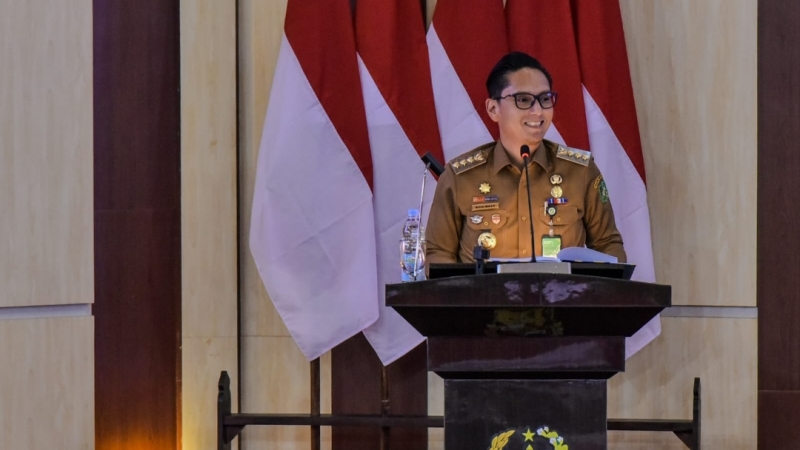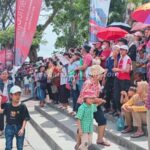The Mayor of Medan has reaffirmed the city government’s commitment to continuously strengthen public services, including the health, education, and basic infrastructure sectors.
This was stated during a Plenary Meeting of the Medan Regional House of Representatives (DPRD), with the agenda of the Regional Head’s Response to the General Views of the Factions on the Draft Regional Regulation for the 2026 Medan City Budget.
It was emphasized that regional spending allocations are directed towards improving the quality of public services, from health and education to public transport and city infrastructure.
It was explained that capital expenditure in the 2026 Draft Budget reaches 20.08%, focused on the construction and improvement of road infrastructure, bridges, drainage, educational and health facilities, and other public service facilities.
“With directed planning and strict implementation oversight, the benefits can be directly felt by the community,” was firmly stated.
In the health sector, the city government will strengthen hospital and community health center services, including improvements to facilities, human resources, and promotive and preventive activities such as health screenings and chronic disease management programs.
It was also stated that the city government targets all community health centers to have Public Service Agency status by 2026 to expand service reach and flexibility.
The importance of improving the welfare of public servants was also highlighted to support a culture of professional, responsive public service free from illegal levies.
The city government is also committed to strengthening the digital system in population and licensing services and optimizing local revenue so that it returns to the community in the form of better services and infrastructure.
Concluding the response, appreciation was expressed for all input from the DPRD factions as strategic notes for policy refinement.
“All suggestions and criticism from the factions will be important material in the further discussion of the 2026 Budget to realize inclusive and equitable services,” it was stated.
Medan Regional House of Representatives (DPRD)
The Medan Regional House of Representatives (DPRD) is the legislative body for the city of Medan in North Sumatra, Indonesia. It was established as part of Indonesia’s decentralization reforms to give regional governments greater autonomy. The DPRD Medan is responsible for creating local regulations, overseeing the city’s budget, and monitoring the performance of the local executive government.
Medan City Budget
It appears there may be a misunderstanding, as “Medan City Budget” is not a cultural site or a place. It refers to the official financial plan for the city of Medan, located in Indonesia. This budget outlines the government’s planned revenues and expenditures for a given fiscal year to fund public services and development projects across the city.
hospital
A hospital is a healthcare institution providing patient treatment with specialized medical and nursing staff. Historically, hospitals originated as places of hospitality and care, often associated with religious orders, with the oldest institutions dating back to ancient Rome and Greece. They have evolved from basic hospices into advanced centers for medicine, surgery, and medical research.
community health center
A community health center is a local medical facility that provides primary and preventative healthcare services to residents, often regardless of their ability to pay. The model in the United States was formally established in the 1960s as part of the “War on Poverty” to address healthcare disparities in medically underserved areas. These centers remain vital institutions, offering accessible and affordable care to their communities.
Public Service Agency
A Public Service Agency is a government body that provides essential administrative services to citizens, such as issuing licenses, processing documents, and offering public information. These agencies have existed in various forms throughout modern governance history, evolving from traditional bureaucratic offices into centralized, often digital-first service hubs. Their core mission remains ensuring accessible and efficient public services while adapting to changing citizen needs and technological advancements.
road infrastructure
Road infrastructure refers to the interconnected system of roads, highways, and bridges designed for vehicle transportation. Its history dates back to ancient civilizations, with the Romans pioneering extensive, durable road networks to facilitate military movement and trade. Modern systems have evolved to support complex economic activity and urbanization, becoming a critical foundation for societal development.
bridges
Bridges are structures built to span physical obstacles like rivers or valleys, enabling transportation and connection between separated areas. Their history dates back thousands of years, with early examples including ancient Roman stone arch bridges and simple rope or log constructions. Modern engineering has produced diverse designs, from suspension bridges to complex overpasses, which continue to facilitate movement and link communities worldwide.
drainage
A drainage system is an engineered infrastructure designed to remove excess water from an area, such as stormwater or wastewater. Historically, one of the earliest and most famous examples is the Cloaca Maxima, a massive sewer built in ancient Rome that helped drain local marshes and channel waste, contributing to the city’s development. Modern drainage is a critical component of public health and urban planning, preventing flooding and waterborne diseases.






